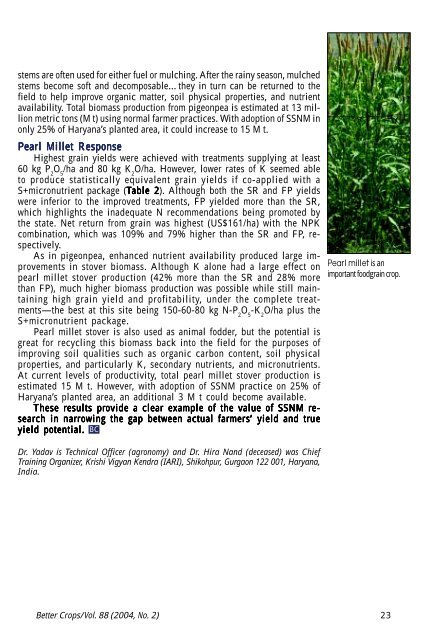Better Crops 2004 #2 - International Plant Nutrition Institute
Better Crops 2004 #2 - International Plant Nutrition Institute
Better Crops 2004 #2 - International Plant Nutrition Institute
Create successful ePaper yourself
Turn your PDF publications into a flip-book with our unique Google optimized e-Paper software.
stems are often used for either fuel or mulching. After the rainy season, mulched<br />
stems become soft and decomposable…they in turn can be returned to the<br />
field to help improve organic matter, soil physical properties, and nutrient<br />
availability. Total biomass production from pigeonpea is estimated at 13 million<br />
metric tons (M t) using normal farmer practices. With adoption of SSNM in<br />
only 25% of Haryana’s planted area, it could increase to 15 M t.<br />
Pearl Millet Response<br />
Highest grain yields were achieved with treatments supplying at least<br />
60 kg P 2<br />
O 5<br />
/ha and 80 kg K 2<br />
O/ha. However, lower rates of K seemed able<br />
to produce statistically equivalent grain yields if co-applied with a<br />
S+micronutrient package (Table 2). Although both the SR and FP yields<br />
were inferior to the improved treatments, FP yielded more than the SR,<br />
which highlights the inadequate N recommendations being promoted by<br />
the state. Net return from grain was highest (US$161/ha) with the NPK<br />
combination, which was 109% and 79% higher than the SR and FP, respectively.<br />
As in pigeonpea, enhanced nutrient availability produced large improvements<br />
in stover biomass. Although K alone had a large effect on<br />
pearl millet stover production (42% more than the SR and 28% more<br />
than FP), much higher biomass production was possible while still maintaining<br />
high grain yield and profitability, under the complete treatments—the<br />
best at this site being 150-60-80 kg N-P 2<br />
O 5<br />
-K 2<br />
O/ha plus the<br />
S+micronutrient package.<br />
Pearl millet stover is also used as animal fodder, but the potential is<br />
great for recycling this biomass back into the field for the purposes of<br />
improving soil qualities such as organic carbon content, soil physical<br />
properties, and particularly K, secondary nutrients, and micronutrients.<br />
At current levels of productivity, total pearl millet stover production is<br />
estimated 15 M t. However, with adoption of SSNM practice on 25% of<br />
Haryana’s planted area, an additional 3 M t could become available.<br />
These results provide a clear example of the value of SSNM re-<br />
search in narrowing the gap between actual farmers’ yield and true<br />
yield potential. BC<br />
Dr. Yadav is Technical Officer (agronomy) and Dr. Hira Nand (deceased) was Chief<br />
Training Organizer, Krishi Vigyan Kendra (IARI), Shikohpur, Gurgaon 122 001, Haryana,<br />
India.<br />
Pearl millet is an<br />
important foodgrain crop.<br />
<strong>Better</strong> <strong>Crops</strong>/Vol. 88 (<strong>2004</strong>, No. 2) 23

















